Note: This piece is part of a series on how Press Forward’s funder coalition is investing according to the initiative’s four investment priorities: local news sustainability, equity, infrastructure and public policy. As Press Forward’s second open grant opportunity is for grants that support the field’s infrastructure, we wanted to start by asking national and local funders about the work they are doing in this area.
By Mark Glaser
When you show off your new house to friends, you don’t typically show them the house’s foundation, plumbing or electrical wiring. Similarly, when people read a local news story, they rarely notice the publishing platform, analytics or training programs that helped make the story possible. This is the unsexy but crucial part of local news: the infrastructure.
Changes in the field have made it a challenge for short-staffed newsrooms to keep up with the latest tools and processes they need to produce stories, reach audiences, raise revenue and more. Support organizations have stepped in to help, with a range of projects.
Press Forward funders have supported everything from Catchlight (visual journalism) to URL Media (a system for advertising across BIPOC-led and -serving newsrooms) to the Racial Equity in Journalism Fund (investments and assistance for BIPOC-led and -serving newsrooms) to the National Trust for Local News (to purchase a printing press for rural papers in Colorado.)
Yet more infrastructure is needed to make it easier to launch and sustain a newsroom long-term. That’s why Press Forward dedicated its second open call to invest up to $20 million in this area.
We talked to four key funders to get their take on how they define infrastructure and their key investments so far.
Marc Lavallee, Director of Technology Product and Strategy/Journalism for Knight Foundation

Knight has spent more than $100 million in local news infrastructure over the past decade.
How do you define local news infrastructure?
I look at it as being all the things that make it easier or possible for a local publisher to ultimately focus on the things that are unique to their community and their circumstances. It’s incredibly wide ranging. Yes, some aspects are technology and tools that they can use, but also hands-on support that they can leverage, whether that’s a kind of a fractional resource or some sort of expertise that’s a phone call away. And it’s also some of the larger scaffolding that makes their kind of organization possible.
The fewer decisions and headaches that aren’t truly specific to a community, the better.
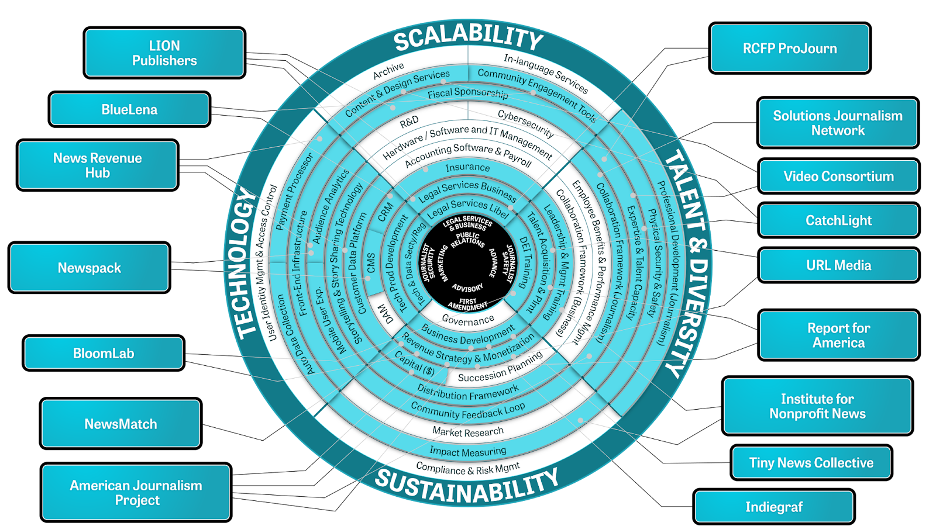
Knight’s infrastructure wheel shows how the foundation thinks about local news support organizations. Read more in a recent News @ Knight newsletter.
What are some recent investments you’ve made in infrastructure?
I’ll talk about three approaches. In the past few years, we’ve made investments in organizations like Indiegraf and Tiny News Collective, who support news founders and early-stage organizations and provide the kind of wraparound services and support to help them grow. And that was both based on each of those organizations having a demonstrated track record of success and fulfilling that mission, but also that there are signals of demand out there for those services.
Those aren’t just technology investments, those aren’t just sustainability investments. Those are about trying to engineer an outcome of healthy news organizations.
Another approach is the work that we’ve done with the Lenfest Local News Infrastructure Fund with Newspack [content management system] and BlueLena [audience strategy and growth tools]. They’ve become pretty established players in their respective markets. Our investment helps them support existing and new organizations at reasonable price points while the publishers continue to grow.
And then a third kind of investment is in organizations like MuckRock to pull together a variety of services that make it really easy for publishers to have one stop shopping for tools. In this case, MuckRock helps with FOIA (Freedom of Information Act) requests and research on political candidates. And we’ve been able to build on that investment in the past few months, as they helped us build the Knight Election Hub.
What does success in infrastructure for a local news outlet look like for you?
A key ingredient of success is having a high degree of confidence that the organization as a whole and each individual has a very deep understanding of the needs of that community and that they feel like they’re meeting those needs as well. And also, that the organization is part of the civic infrastructure in a way that’s not just a recorder of events, but it is something that is helping the community understand itself better and, in some cases, challenging the community, as the Knight brothers would say, to pursue their own true interests, their long-term interests, and not just what’s happening today.
The best manifestation of that is some degree of reader revenue, whether that’s donations or subscriptions. We take the view that different things will work in different places. Folks need multiple revenue streams, and different communities have different levels of resources to support those. We have to be able to answer the question: does the community show that it values the publications, and if not, what can be done about that?
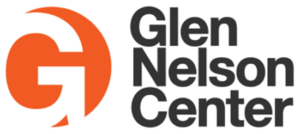
Jeff Freeland Nelson, Executive Director of the Glen Nelson Center at American Public Media Group
Glen Nelson Center’s Horizon Fund is investing $10 million in early-stage media companies to help build the newsroom of the future.
How would you define local news infrastructure, and what’s your goal with infrastructure investments?
We are looking for tools and technology that newsrooms and journalists can use to do their jobs better and more efficiently. Over the next five years, we’ve set aside $10 million to invest in media startups, with $5 million pledged to Press Forward for investments in companies supporting local journalism.
We have three primary investment objectives. The first is learning – we want to learn from startups as a Press Forward partner, as American Public Media Group, and as Minnesota Public Radio and Southern California Public Radio. We’re also looking for business development opportunities. Can we partner with them? Can we work with them to reach new audiences? Can we scale their technology to newsrooms across the country? Last (but not least), we expect a financial return, which we can use to fund future investments.
What are some recent investments you’ve made in infrastructure?
A great example is a startup called Hamlet, based in the San Francisco Bay Area. Hamlet has created an AI tool to ingest mountains of municipal data, from city council and planning commission minutes, agendas, and meeting recordings to proposals and voting records. All pulled into one big searchable AI-enabled tool.
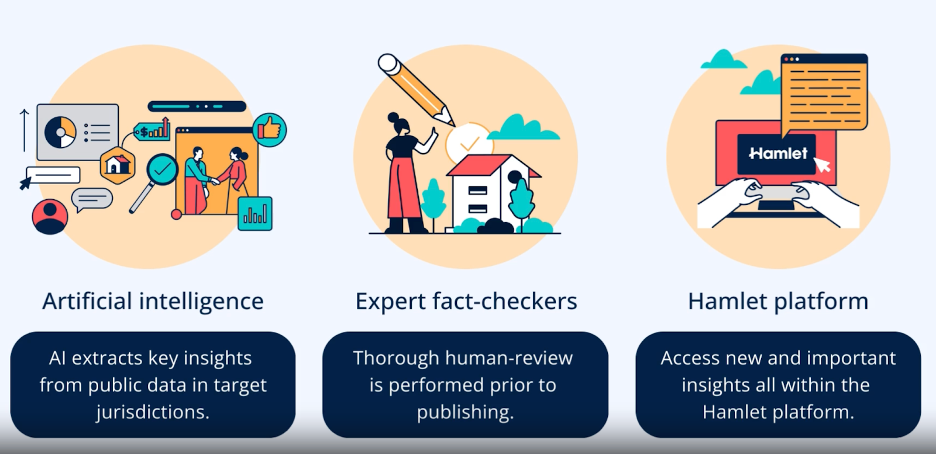
Graphic explaining what Hamlet does
We made an early-stage investment in Hamlet around the premise that those tools will give local journalists a powerful lens to look at city government and how decisions are being made.
We’ve also invested in Rolli, based in Los Angeles. They have created an AI-enabled expert database – essentially a supercharged Rolodex – to help journalists find better and more diverse sources. They have also created an award-winning social media intelligence tool that helps cut through disinformation and get at what is happening, not just what people post about it.
We are about to invest in LeadStory, a startup launched in Sidney, Australia, and recently moved to the United States. They’ve created a personalized news aggregation app optimized for connected cars and smart TVs. There is a big opportunity for more news content in cars – including video, as cars become more autonomous. The LeadStory app creates a personalized news feed that licenses paid content from leading global, national and local news organizations and delivers it seamlessly to your car, phone and television. We hope this will become a new distribution channel for local news organizations, as well as an important new source of revenue.
What would an ideal infrastructure for a newsroom look like for you?
The newsroom of the future will deploy a lot more technology than we’re using today. These tools will create powerful new ways to report the news and opportunities to be more efficient in the production process. It will also mean newsrooms must continually develop and update ethical frameworks as they deploy constantly evolving and more powerful technology.
AI-enabled analytical and data mining tools will help discover new insights into what is happening in our communities and bring to light facts that are buried in oceans of dark data. There will be technology we can’t even imagine today enabling journalists to seek out and report the news in new and powerful ways – and, I hope, to get at the truth in a world full of AI-enabled disinformation.
We are already seeing a lot of tools to streamline the media production process. These range from transcription and translation tools to nearly magical AI-enabled audio and video editing tools. Generative AI is getting a lot of attention, especially the development of shockingly realistic synthetic voices and hosts. While these tools are interesting (and often creepy), the real benefit to newsrooms will come from using AI-enabled tools as part of their normal content production process, reducing editing times from hours to minutes so they can devote more time and resources to reporting the news.
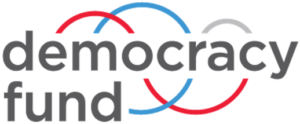
Teresa Gorman, Associate Director, Public Square
Democracy Fund has invested more than $15.75 million in 10 local news ecosystems across the U.S. since 2016.
How do you define local news infrastructure in your investments?
When it comes to infrastructure, we ask two critical questions: 1) What do local news ecosystems need to be sustainable and resilient? 2) What investments will prioritize historically marginalized people and communities?
We believe that these combined factors enable ecosystems that meet communities’ information needs. In moments of transition and uncertainty in particular, journalists of color have historically provided a blueprint for media that builds power and mobilizes communities around news and information. We know that is a solid blueprint for the infrastructure to build.
With this specific local and equity lens, our definition of infrastructure acknowledges the many interconnected needs and funding opportunities that add up to a healthy ecosystem. When we think about ecosystems, say a garden’s ecosystem, we need a lot more than soil and plants. We need the water, fertilizer, sun, shade, labor, and expertise for our gardens to be a success.
Our investments have included shared services, coordinated fundraising, legal support, safety and security services, network-building and beyond. These are the multifaceted resources that an ecosystem of local news organizations need to be resilient in their day-to-day work.
Additionally, over time we’ve realized that instead of adopting one model and scaling it everywhere, we have to embrace a ‘spread’ approach. No geography or location is cookie-cutter. Things that will grow in New Mexico won’t grow the same way in Chicago. We’ve developed and funded ideas, models and frameworks and then supported the networks and pathways for leaders to adapt them to their local context. In order to spread these different services and ideas, these networks have to be strong. This means including network weaving and adaptive leaders who will be able to respond to changes and challenges that come their way in the future.
What are some examples of your infrastructure investments at Democracy Fund, especially related to the local chapters?
One example is investing in collaborative and transformational leaders. Local ecosystem leaders are able to identify what their ecosystems need, take a scan of regional and national offerings, and serve as a guide and facilitator to newsrooms in their state for these resources. Without this leadership, we know newsrooms are often overwhelmed. In New Jersey, the Center for Cooperative Media (CCM) has done extensive ecosystem listening and sets their strategy by what they hear. Press Forward New Jersey, led by the NJ Civic Information Consortium and Community Foundation of New Jersey, is able to learn from CCM, and can use this knowledge to inform their funding strategies.
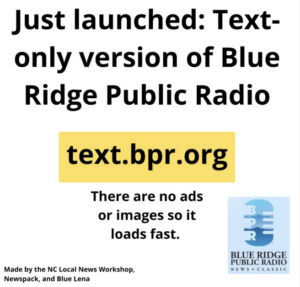
Collaboration helped NC newsrooms create special “light” websites and texting to help residents in the aftermath of Hurricane Helene
This kind of guidance helps make sense of specific local needs during moments of crisis, too. We saw these benefits this year in North Carolina, where North Carolina Local News Lab Fund, which leads Press Forward NC, has supported NC Local News Workshop at Elon University as a backbone organization in their ecosystem. After Hurricane Helene hit, the workshop was able to rally editors and support for news organizations in Western North Carolina, while the Fund paired direct grants to many of the same organizations.
Investing in infrastructure also doesn’t have to be specific to geography. Our Press Forward specific infrastructure investments this year have focused on expanding infrastructure that we know works and is sometimes overlooked. Our aligned grantmaking this year includes supporting capacity building for Racial Equity in Journalism Fund grantees, the News Futures leadership coalition, and the NewsMatch DEI Fund. We’re also reinvesting in legal services via Reporters Committee for Freedom of the Press, Lawyers for Reporters and the Legal Clinic Fund for Local News at a time when we know that press freedom will face existential challenges.
What would you consider the ideal infrastructure for local newsrooms?
The ideal infrastructure for local newsrooms is one that creates an enabling environment for people of color and marginalized identities that we need to lead courageously and to transform the journalism system. To get there, we have to turn to the experts who are leading that work. It’s not going to be one size fits all. It may change over time, but if we have a solid foundation for independent and civic media to evolve and grow, then we’re sure to see the gardens, seeded by Press Forward and other funders, grow beyond what we could have imagined.

Tom Gougeon, President, Gates Family Foundation
Gates Family Foundation has been committed to supporting community-based newsrooms and promising new ventures in Colorado through the Colorado Media Project philanthropic initiative and Press Forward Colorado.
How would you define infrastructure for local news and your philosophy for supporting it in Colorado?
From early on, we thought about local news as an ecosystem that we were trying to build. There was an ecosystem historically and then that’s changed and been disrupted pretty dramatically and so part of it is what’s the new ecosystem going to look like? There’s a role certainly for supporting outlets directly and in some cases filling gaps with new entrants and people that emerge including nonprofit digital-only news sources.
We also felt that if you’re really going to build that ecosystem there is infrastructure that we need. The Colorado Media Project was just step one. Where do we all go to worry about this, share information and try to accumulate more partners who want to invest in this world? We realized we had to work on a variety of topics, some had to do more with the business side of journalism and information, about revenue models and how you engage an audience and build an audience.
It just felt like there are certainly some great resources out there nationally. But how do we match up people’s needs locally with all those resources, and what resources are missing? We were trying to advance the idea that the future is probably a more collaborative future and less of a competitive future. So, the Colorado News Collaborative, the COLab, a local media resource hub, was meant to be the kind of place to work on some of those things regarding sustainability and support multi-outlet collaboration.
There’s also a theme with respect to diversity in the sector, both who’s in the newsroom, but also how newsrooms are covering diverse communities and the challenges historically of not doing that particularly well. We’ve supported the Colorado Ethnic Media Exchange to help smaller publishers serving communities of color to meet up each week and discuss ways they can collaborate. That includes presenting themselves as a network for ad sales.
What are some examples of your recent investments in infrastructure?
One example is we worked with the National Trust for Local News when they acquired a chain of newspapers here early on in their evolution. And we reached this place where two of the major printing facilities in the Front Range in Colorado have shut down. And so that created a challenge. A lot of the smaller publishers relied on them. And many of these are organizations that while they’re working on having more digital presence, they’re still primarily print, and their advertising revenue is primarily driven by print.
With those facilities closing, it just pushed people to even more expensive options and options that were physically farther away. In the end we got a group of investors together to buy and bring a printing press here in the hopes of setting it up to meet that need and also give those smaller publishers not only better economics but ideally more control over their destinies.
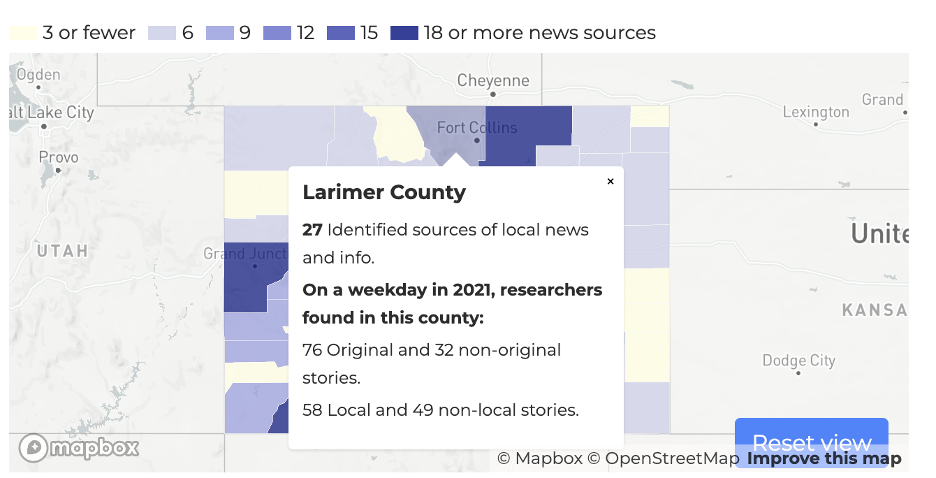
Colorado News Mapping Project
We’ve also funded multiple surveys of consumers of news and information in the state just to see periodically what people are relying on for news and where they are going.
And we shared that information obviously pretty openly with everybody who cares and is interested. It allows us to understand the kind of patterns and differences in urban and rural settings and with different subpopulations. And then there was a separate project, the Colorado News Mapping Project, that was done with a group of partners that really tried to figure out county by county what people were relying on at a much more granular level.
What would you consider an ideal infrastructure for local news?
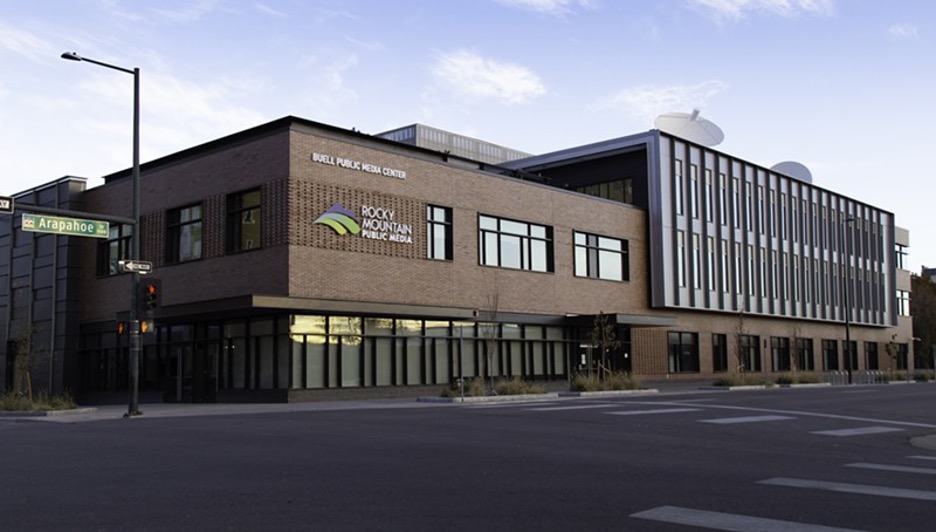
Photo used with permission of Rocky Mountain PBS
One example is Rocky Mountain PBS, and the Buell Public Media Center in Denver (seen above). It’s got a lot of community space. It has a small black box theater. It has two radio stations. It has local production facilities where citizens can produce their own content. And then a shared physical newsroom, COLab, is there, too.
It’s an interesting mashup of a lot of different things. It’s also a building with tons of capabilities, like the cross-media platforms and all kinds of events and activities.
They opened it during the pandemic, so it took a little bit of time for it to reach its potential.
It’s a place where reporting happens in journalism and production, but it’s much more like a civic space and community venue. In a world where it’s much more of a conversation with your audience and not a one-way street, you need to be physically available and present in some form.
*****
What these funders have in common is a desire to build a flexible, long-lasting local news infrastructure that helps newsrooms do their work more efficiently, reach new audiences and secure a financial future. Press Forward will continue to support that infrastructure so that news publishers can focus on serving communities around the country.
Mark Glaser is the Director of Business and Program Development for the New Mexico Local News Fund. He is also a communications consultant at Knight Foundation and Tiny News Collective and was the founder and executive editor of MediaShift.org.
